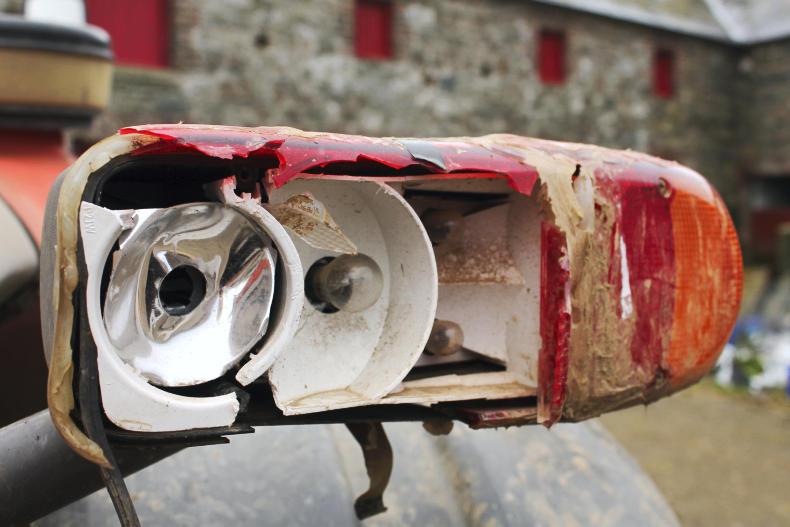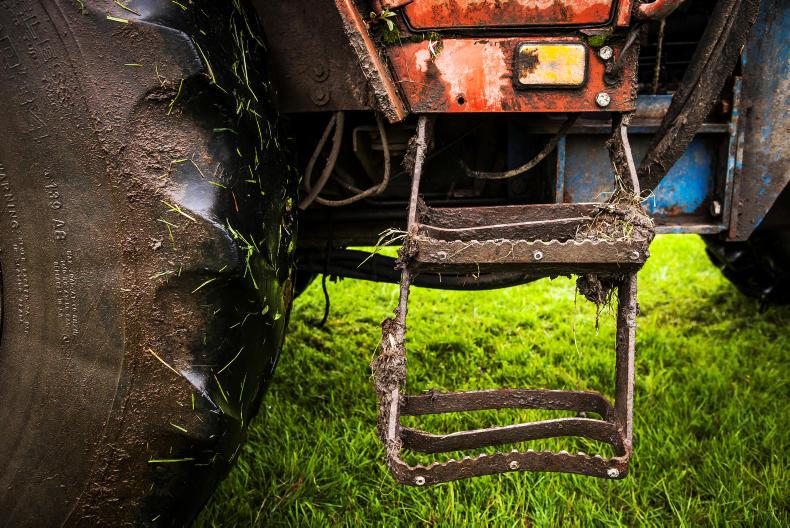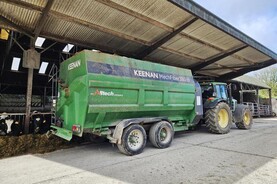Heavy rainfall has caused an abrupt end to the grazing season in many parts of the country. For those in drier areas, it has brought about changes in management, such as housing cows by night or on/off grazing in the case of dairy herds. While situations differ, the reality is that for many it has resulted in feeding equipment being called into action earlier than anticipated.
The timeline to dust off the cobwebs and carry out inspections is getting increasingly shorter. Despite the pressure, these inspections should remain a priority. As well as ensuring equipment is working at optimum performance, any possible safety risks need to rectified.
The main machine
The tractor is the one vital piece of equipment that is used most frequently on livestock farms. It has a number of areas that should be given the once over:
Lights and visibility: With daylight hours reducing fast, tractors will be operating more frequently under the cover of darkness. Farmers need to ensure all lights are in place and functioning correctly. These include headlights, work lights, brake lights, indicators and a flashing beacon. It’s very important to have the correct lighting not only for your own visibility, but for all other road users. Side and internal mirrors should be present.
Adequate lighting is vital to operate the equipment safely and also improve visibility.
Tyres: Worn or structurally damaged tyres increase the risk of a blowout when handling heavy materials, while worn tyres also significantly increase the risk of accidents on wet or icy surfaces. Look out for perished tyres or weak spots in the wall of the tyre that are prone to bulges. The front tyres especially come under pressure where the tractor has a front loader and is handling bales or shear grabs full of silage. Mounting and dismounting: If you count the number of times you mount and dismount a tractor during a busy winter’s day, it is sure to surprise you. Check that there are no cracks in the steps or wear and tear around bolts. The surface of the step is also important to watch, as slips can easily take place with dirt or material on the soles of wellingtons or boots.
Damaged steps or worn surfaces will increase the risk of falls when mounting or dismounting the tractor.
Loader wear and tear: The starting point is generally checking the loader brackets that attach the loader to the tractor. Any cracks or sign of wear pose a serious safety risk and should be dealt with immediately. It is also advisable to check the torque on the bolts which attach the brackets to the tractor. All grease points on the loader should be checked to make sure they are taking grease. The hydraulic cylinder should be checked over, along with all hydraulic hoses and fittings for any leaks. Take particular care to check if hoses are perished.
Farmers should also inspect the loader’s headstock. It is vital that the locking mechanism holding the front attachment in place is working correctly. While not related to loader condition, tractors should always be parked in a safe manner with the loader on the ground or secured in an upright position. The tractor should never be parked with a loader at head height, even for a short period. When transporting materials on uneven ground, be sure that the tractor is well balanced with the appropriate weight at the rear of the tractor where required and with the loader in a lowered position.
Handbrake: A high percentage of accidents are related to people getting trapped by vehicles which have rolled after dismounting. Ensure the handbrake is in good working order and never take chances when entering potential trap zones. Fire extinguisher: A fire extinguisher is a small cost given the vital role it can have if an electrical fault occurs. A small 1kg fire extinguisher can be purchased for €20 to €30 and should be at the top of the list of things to purchase. Shear grab
After the tractor, the shear grab is probably the next most commonly used piece of equipment on beef and dairy farms.
Hydraulic rams: Shear grabs work using hydraulic power to open and close, and require adequate oil pressure for maximum speed. Check the ram’s seals to ensure they are not damaged or leaking. Leaking may be caused by pitted chrome on the cylinders, which in time damage the seals. Oil leaks over a long period of time will drain oil from the tractor or loader, causing further problems.Hoses and fittings: As was the case with the loader, hydraulic fittings or quick attachment mechanisms need to be checked. The brackets are what link the grab to the loader, meaning high levels of stress and strain would occur here, so check for cracks in welds. Ensure that both the loader and the brackets are lining up correctly and that the locking mechanism is fully engaged. 
Connections and fittings should be checked to identify any leaks.
A worn or faulty connection will leak oil and not hold pressure, resulting in a poor-performing shear grab. The sharp wire in perished hoses can cause cuts, as well as showing a weakness in the hose. These weakened areas will eventually burst, leaking oil and creating slippery surfaces.
The same advice for a shear grab applies to diet feeders, with the additional components of PTOs and coupling attachments, which are also important parts to check.
The cheapest mechanic
No matter what piece of equipment we are talking about, grease is the cheapest investment you can make to help keep the implement performing optimally. Blocked or stubborn grease nipples often deter greasing. New grease nipples are inexpensive and it is worth having a few spare in the tool kit.
Heavy rainfall has caused an abrupt end to the grazing season in many parts of the country. For those in drier areas, it has brought about changes in management, such as housing cows by night or on/off grazing in the case of dairy herds. While situations differ, the reality is that for many it has resulted in feeding equipment being called into action earlier than anticipated.
The timeline to dust off the cobwebs and carry out inspections is getting increasingly shorter. Despite the pressure, these inspections should remain a priority. As well as ensuring equipment is working at optimum performance, any possible safety risks need to rectified.
The main machine
The tractor is the one vital piece of equipment that is used most frequently on livestock farms. It has a number of areas that should be given the once over:
Lights and visibility: With daylight hours reducing fast, tractors will be operating more frequently under the cover of darkness. Farmers need to ensure all lights are in place and functioning correctly. These include headlights, work lights, brake lights, indicators and a flashing beacon. It’s very important to have the correct lighting not only for your own visibility, but for all other road users. Side and internal mirrors should be present.
Adequate lighting is vital to operate the equipment safely and also improve visibility.
Tyres: Worn or structurally damaged tyres increase the risk of a blowout when handling heavy materials, while worn tyres also significantly increase the risk of accidents on wet or icy surfaces. Look out for perished tyres or weak spots in the wall of the tyre that are prone to bulges. The front tyres especially come under pressure where the tractor has a front loader and is handling bales or shear grabs full of silage. Mounting and dismounting: If you count the number of times you mount and dismount a tractor during a busy winter’s day, it is sure to surprise you. Check that there are no cracks in the steps or wear and tear around bolts. The surface of the step is also important to watch, as slips can easily take place with dirt or material on the soles of wellingtons or boots.
Damaged steps or worn surfaces will increase the risk of falls when mounting or dismounting the tractor.
Loader wear and tear: The starting point is generally checking the loader brackets that attach the loader to the tractor. Any cracks or sign of wear pose a serious safety risk and should be dealt with immediately. It is also advisable to check the torque on the bolts which attach the brackets to the tractor. All grease points on the loader should be checked to make sure they are taking grease. The hydraulic cylinder should be checked over, along with all hydraulic hoses and fittings for any leaks. Take particular care to check if hoses are perished.
Farmers should also inspect the loader’s headstock. It is vital that the locking mechanism holding the front attachment in place is working correctly. While not related to loader condition, tractors should always be parked in a safe manner with the loader on the ground or secured in an upright position. The tractor should never be parked with a loader at head height, even for a short period. When transporting materials on uneven ground, be sure that the tractor is well balanced with the appropriate weight at the rear of the tractor where required and with the loader in a lowered position.
Handbrake: A high percentage of accidents are related to people getting trapped by vehicles which have rolled after dismounting. Ensure the handbrake is in good working order and never take chances when entering potential trap zones. Fire extinguisher: A fire extinguisher is a small cost given the vital role it can have if an electrical fault occurs. A small 1kg fire extinguisher can be purchased for €20 to €30 and should be at the top of the list of things to purchase. Shear grab
After the tractor, the shear grab is probably the next most commonly used piece of equipment on beef and dairy farms.
Hydraulic rams: Shear grabs work using hydraulic power to open and close, and require adequate oil pressure for maximum speed. Check the ram’s seals to ensure they are not damaged or leaking. Leaking may be caused by pitted chrome on the cylinders, which in time damage the seals. Oil leaks over a long period of time will drain oil from the tractor or loader, causing further problems.Hoses and fittings: As was the case with the loader, hydraulic fittings or quick attachment mechanisms need to be checked. The brackets are what link the grab to the loader, meaning high levels of stress and strain would occur here, so check for cracks in welds. Ensure that both the loader and the brackets are lining up correctly and that the locking mechanism is fully engaged. 
Connections and fittings should be checked to identify any leaks.
A worn or faulty connection will leak oil and not hold pressure, resulting in a poor-performing shear grab. The sharp wire in perished hoses can cause cuts, as well as showing a weakness in the hose. These weakened areas will eventually burst, leaking oil and creating slippery surfaces.
The same advice for a shear grab applies to diet feeders, with the additional components of PTOs and coupling attachments, which are also important parts to check.
The cheapest mechanic
No matter what piece of equipment we are talking about, grease is the cheapest investment you can make to help keep the implement performing optimally. Blocked or stubborn grease nipples often deter greasing. New grease nipples are inexpensive and it is worth having a few spare in the tool kit.









 This is a subscriber-only article
This is a subscriber-only article









SHARING OPTIONS: